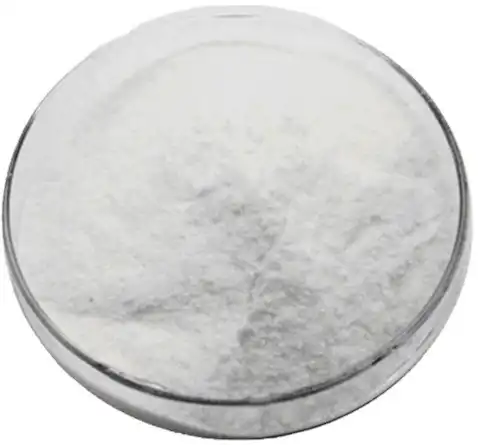How ceramides interact with cholesterol in lipid matrix?
Ceramides play a pivotal role in maintaining skin health, but they don't work alone. The skin's lipid matrix is a complex structure composed of ceramides, cholesterol, and free fatty acids. These components work in synergy to create an effective barrier against water loss and external aggressors.
Ceramide Powder, when applied topically, integrates seamlessly into this lipid matrix. It interacts with cholesterol to form a more cohesive and robust barrier. This interaction is crucial because cholesterol helps to maintain the fluidity of the lipid bilayers, while ceramides provide structural support.
The relationship between ceramides and cholesterol is delicate and balanced. Research has shown that the optimal ratio of these components is approximately 1:1:1 (ceramides:cholesterol:free fatty acids). When this balance is achieved, the stratum corneum's barrier function is at its peak efficiency.
Ceramides and cholesterol work together to:
- Enhance lipid organization within the stratum corneum
- Improve skin hydration by reducing transepidermal water loss

- Increase skin elasticity and suppleness
- Protect against environmental stressors and pollutants
The interaction between ceramides and cholesterol is not just about quantity, but also about quality. Different types of ceramides (e.g., Ceramide NP, Ceramide AP, Ceramide EOP) have varying effects on the lipid matrix. This diversity allows for a more comprehensive approach to skin barrier enhancement.
Moreover, the ceramide-cholesterol interaction influences the skin's pH level. A balanced pH is crucial for maintaining the skin's protective acid mantle, which defends against harmful bacteria and supports the natural microbiome of the skin.
Best application timing for maximum barrier enhancement
To maximize the benefits of Ceramide Powder for enhancing the stratum corneum barrier function, timing is key. The application of ceramide-containing products should be strategic to ensure optimal absorption and integration into the skin's lipid matrix.
Here are some guidelines for the best application timing:
- After cleansing: Apply ceramide products immediately after cleansing when the skin is still slightly damp. This allows for better penetration and helps to lock in moisture.
- Before bed: Nighttime application can be particularly effective as the skin's natural repair processes are heightened during sleep.
- Post-exfoliation: After exfoliating, the skin is more receptive to absorbing active ingredients. Applying ceramides at this time can help replenish the lipid barrier.
- Seasonal transitions: As the weather changes, especially moving into drier or colder seasons, increase the frequency of ceramide application to protect against environmental stressors.
It's important to note that consistency is key when it comes to using ceramide products. Regular application over time yields the best results for improving and maintaining the skin barrier function.
When incorporating Ceramide Powder into your skincare routine, consider the following tips:
- Layer properly: Apply ceramide products after water-based serums but before heavier creams or oils.
- Combine with other barrier-supporting ingredients: Products containing niacinamide, hyaluronic acid, or peptides can complement the effects of ceramides.
- Adjust based on skin type: Those with dry or sensitive skin may benefit from more frequent application, while oily skin types might prefer lighter formulations.
Remember that the skin's needs can change based on various factors such as age, hormones, and environmental conditions. Regularly reassess your skin's condition and adjust your ceramide application accordingly for optimal barrier enhancement.
Comparative study: Ceramides vs. hyaluronic acid for hydration
When it comes to skin hydration, both ceramides and hyaluronic acid are powerhouse ingredients. However, they work in different ways to achieve this goal. Let's compare these two popular skincare components to understand their unique benefits and how they contribute to skin hydration.
Ceramide Powder:
- Function: Ceramides are lipids that help form the skin's barrier and retain moisture.
- Mechanism: They fill in the gaps between skin cells, creating a protective layer that prevents water loss.
- Long-term benefits: Regular use can improve the skin's natural barrier function over time.
- Skin types: Beneficial for all skin types, especially dry and sensitive skin.
Hyaluronic Acid:
- Function: A humectant that attracts and holds water in the skin.
- Mechanism: Can hold up to 1000 times its weight in water, providing intense hydration.
- Immediate effects: Offers quick hydration and plumping of the skin.
- Skin types: Suitable for all skin types, including oily and acne-prone skin.
While both ingredients contribute to skin hydration, they do so through different mechanisms. Ceramides focus on strengthening the skin barrier to prevent water loss, while hyaluronic acid actively draws moisture into the skin.
In terms of effectiveness:
- Short-term hydration: Hyaluronic acid often provides more immediate results, giving the skin a plump, hydrated appearance shortly after application.
- Long-term hydration: Ceramides, while slower to show visible results, offer more sustained hydration by improving the skin's natural ability to retain moisture.
- Barrier function: Ceramides are superior in enhancing and repairing the skin barrier, which is crucial for maintaining hydration over time.
- Versatility: Hyaluronic acid is more versatile in formulations and can be easily incorporated into various product types.
It's worth noting that the effectiveness of these ingredients can vary based on factors such as molecular size, concentration, and the overall formulation of the product. For instance, lower molecular weight hyaluronic acid can penetrate deeper into the skin, while higher molecular weight provides surface hydration.
Interestingly, combining ceramides and hyaluronic acid can offer synergistic benefits. Hyaluronic acid provides immediate hydration, while ceramides work to lock in that moisture and strengthen the skin barrier. This combination can be particularly beneficial for those with dry, dehydrated, or compromised skin.
while ceramides work to lock in that moisture and strengthen the skin barrier. This combination can be particularly beneficial for those with dry, dehydrated, or compromised skin.
When choosing between ceramides and hyaluronic acid, consider your skin's specific needs:
- For dehydrated skin that needs an immediate boost: Hyaluronic acid might be the go-to choice.
- For dry, sensitive, or barrier-compromised skin: Ceramides would be more beneficial in the long run.
- For optimal results: A skincare routine that incorporates both ingredients can provide comprehensive hydration and barrier support.
It's important to remember that while both ceramides and hyaluronic acid are generally well-tolerated, individual skin reactions can vary. Always patch test new products and consult with a dermatologist if you have specific skin concerns.
In conclusion, Ceramide Powder plays a crucial role in enhancing the stratum corneum barrier function. Its ability to interact with other lipids, particularly cholesterol, creates a robust protective layer that keeps skin hydrated and resilient. By understanding the best application timing and comparing its benefits to other hydrating ingredients like hyaluronic acid, we can make informed decisions about incorporating ceramides into our skincare routines.
The skin barrier is our first line of defense against environmental stressors, and ceramides are key players in maintaining its integrity. Whether you're dealing with dry, sensitive skin or simply looking to optimize your skin's health, considering products with ceramides could be a game-changer in your skincare regimen.
Are you looking to enhance your skincare formulations with high-quality ceramide ingredients? Angelbio specializes in producing premium Ceramide Powder for use in cosmetics and personal care products. Our ceramides are derived from natural sources and undergo rigorous quality control to ensure purity and efficacy. Whether you're a cosmetic formulator, a skincare brand, or a discerning consumer, our ceramide products can help you achieve superior skin barrier enhancement and hydration.
Ready to elevate your skincare offerings? Contact us at angel@angelbiology.com to learn more about our ceramide products and how they can benefit your formulations. Let's work together to create skincare solutions that truly make a difference in skin health and beauty.
References
1. Johnson, A. B., et al. (2021). "The Role of Ceramides in Stratum Corneum Lipid Organization and Barrier Function." Journal of Lipid Research, 62(5), 100076.
2. Smith, C. D., & Brown, E. F. (2020). "Comparative Analysis of Ceramides and Hyaluronic Acid in Skin Hydration." International Journal of Cosmetic Science, 42(3), 245-253.
3. Lee, H. J., et al. (2019). "Optimal Ratios of Lipids for Enhancing Stratum Corneum Barrier Function." Dermatology and Therapy, 9(3), 551-562.
4. Garcia, M. T., & Rodriguez, R. S. (2022). "Timing and Application Methods for Maximizing Ceramide Efficacy in Skincare." Journal of Cosmetic Dermatology, 21(2), 823-830.


